Manage your Agora account
This page shows you how to use Agora Console to manage all aspects of your Agora account.
Get Started with Agora
To join a real-time engagement session powered by Agora, you need to provide an App ID and temp Token. This page shows you how to get the information.
Create an Agora account
Sign up here to create an Agora account. After sign-up, you can log in here.
Create an Agora project
Once you finish the sign-up process, you can create an Agora project in Agora Console.
To create an Agora project, do the following:
-
In Agora Console, open the Project Management page.
-
Click Create.
-
Follow the on-screen instructions to enter a project name and use case, and check Secured mode: APP ID + Token (Recommended) as the authentication mechanism.
-
Click Submit. You can now see the project on the Project Management page.
Get the App ID
Agora automatically assigns each project an App ID as a unique identifier.
To copy this App ID, find your project on the Project Management page in Agora Console, and click the copy icon in the App ID column.
Get the App Certificate
When generating a token on your app server, you need to fill parameters such as the App ID, channel name, user ID, and App Certificate.
To get an App Certificate, do the following:
-
On the Project Management page, click Config for the project you want to use.
-
Click the copy icon under Primary Certificate.
Generate a Customer ID and Customer Secret
The Agora RESTful API uses a Customer ID and Customer Secret for basic HTTP authorization.
To generate a set of Customer ID and Customer Secret, do the following:
-
In Agora Console, click the account name in the top right corner, and click RESTful API from the drop-down list to enter the RESTful API page.
-
Click Add a secret, and click OK. A set of Customer ID and Customer Secret is generated.
-
Click Download in the Customer Secret column. Read the pop-up window carefully, and save the downloaded
key_and_secret.txtfile in a secure location.
Generate a temporary token
To ensure communication security, best practice is to use tokens to authenticate the users who log in to Signaling from your app.
To generate a temporary Signaling token:
-
In Agora Console > Project Management, select your project and click Configure.
-
In your browser, navigate to the Agora token builder.
-
Choose the Agora product your user wants to log in to. Fill in App ID and App Certificate with the details of your project in Agora Console.
-
Customize the token for each user. The required fields are visible in Agora token builder.
-
Click Generate Token
The token appears in Token Builder.
-
Add the token to your app.
Agora Console Overview
Agora Console is the unified portal for you to configure, purchase, and manage Agora products and services. This page introduces the main features of Agora Console.
Overview dashboard
After logging in to Agora Console, you see the overview dashboard. The dashboard displays a summary of important statistics and provides quick access to projects, billing, documentation, and code samples.
Features
Console provides the following main features:
-
Create and manage projects
Create a project, and get the App ID and app certificate to generate an Video SDK temporary token. See Create and Manage Projects.
-
Check usage
Check the usage amount generated by each project or all of them. See Check Usage.
-
Manage members and roles
Add members to your account, and set them as different roles with specified permissions. See Manage Members and Roles.
-
Billing center
Add money to your account, view your transactions, and make withdrawal requests. See Billing Center.
-
Submit a ticket
If you have any questions about Agora products, submit a ticket.
-
Customer ID and Customer Secret
To use Agora RESTful APIs, you need a set of Customer ID and Customer Secret. See Generate a Customer ID and Customer Secret.
-
Agora Analytics
Track and analyze the usage and quality data of real-time communication products through highly visualized reports in order to spot issues and find root causes. For more information, see the Agora Analytics overview.
Agora Extensions Marketplace
Gain access to extensions that rapidly add fun features to your app on top of Agora SDKs. For more information, see the Extensions Marketplace overview.
Sign up and Log in
Before using Agora products and services, you need to create an Agora account.
This page shows how to sign up for an Agora account and log in to Agora Console.
Sign up with an email address
-
Go to the signup page.
-
Fill in your email address.
-
Carefully read the Terms of Service, Privacy Policy, and Acceptable Use Policy, and then select the checkbox.
-
Click Continue.
-
Fill in your verification code, and click Confirm.
-
Follow the on-screen instructions to fill in your name, company name, and phone number, and set up your password. Then click Continue.
Sign up with a phone number
-
Go to the signup page.
-
Click Switch to phone sign up under the text box.
-
Fill in your phone number.
-
Carefully read the Terms of Service, Privacy Policy, and Acceptable Use Policy, and then select the checkbox.
-
Click Continue.
-
Fill in your verification code, and click Confirm.
-
Follow the on-screen instructions to fill in your name, company name, and email address, and set up your password. Then click Continue.
Sign up with a third-party account
-
On the Console login page, choose a third-party account you want to use.
-
Follow the on-screen instructions to complete verification.
-
Click Create a new account.
-
Carefully read the Terms of Service, Privacy Policy, and Acceptable Use Policy, and then select the checkbox.
-
Click Continue.
Once you sign up successfully, your account is automatically logged in. Follow the on-screen instructions to create your first project and test out real-time communications.
For later visits, log in to Agora Console with your phone number, email address, or linked third-party account.
Manage profile
This page shows how to view and edit the profile of your Agora account.
Enter the Profile page
To enter the Profile page, follow these steps:
-
Log in to Agora Console.
-
Click your account name in the top-right corner, and select your account name from the dropdown menu.
On the Profile page, you can view and edit your language setting, phone number, email address, password, and login methods.
Change language setting
-
Enter the Profile page.
-
In the dropdown menu of Language, select English or 中文.
-
Click Save.
Change phone number, email address, or password
-
Enter the Profile page.
-
Find Phone, E-mail, or Password, then click Update or Reset.
-
Follow the on-screen instructions to complete.
Reset your password
If you forget your password, follow these steps to reset it:
-
Go to the login page, and click Forget password.
-
Fill in your email address, and click Send email. Agora sends an email to you.
-
Follow the instructions in the email to reset your password.
Link a third-party account
Follow these steps to link a third-party account with your Agora account:
-
Enter the Profile page.
-
Find GitHub, WeChat, or Google, then click Connect.
-
Follow the on-screen instructions to complete.
Create and Manage Projects
This page shows how to create a project, view project information, and manage app certificates in Agora Console.
Restrictions
-
If your account has multiple members, only those with the role of Admin, Engineer, or an authorized custom role have access to the Project Management page.
-
Each Agora account can create up to 10 projects, including deleted projects. If you need to create more projects, contact Agora by submitting a ticket.
Create an Agora project
To create an Agora project, do the following:
-
Enter the Project Management page.
-
Click Create.
-
Follow the on-screen instructions to enter a project name and use case, and check Secured mode: APP ID + Token (Recommended) as the authentication mechanism.
-
Click Submit. You can now see the project on the Project Management page.
View project information
For a project listed on the Project Management page, you can do the following:
-
View basic information, such as the stage, name, and creation date of the project.
-
Click the copy icon and to copy the App ID of the project.
-
Click Config to enter the project detail page, where you can view and configure App certificate, Project status, and Extensions.
Manage app certificates
An app certificate is a string generated by Console to enable token authentication. For different security requirements, Agora provides the following app certificate options:
-
Primary certificate: This certificate is used to generate tokens for temporary use or production environments.
-
Secondary certificate: This certificate is used to generate tokens for production environments only and does not apply to RESTful APIs.
-
No certificate: This certificate appears only if you choose APP ID as the authentication mechanism when creating a project. In this case, you can complete authentication with the App ID only.
If you have both No certificate and Primary/Secondary certificate in your project, you can either complete authentication with the App ID only or use tokens generated by the Primary/Secondary certificate for authentication.
Enable the primary certificate
For high-security scenarios, enable the primary certificate as follows:
-
If you choose APP ID + Token as the authentication mechanism when creating a project, the primary certificate is enabled by default. On the project detail page, you can click the the copy icon under Primary certificate to view and copy it. In this case, you need to use the token generated by the Primary certificate for authentication.
-
If you choose APP ID as the authentication mechanism when creating a project, you need to enable the primary certificate manually. On the project detail page, click the switch under Primary certificate to enable it.
Once the primary certificate is enabled, you can click the copy icon to view and copy it. In this case, you can either complete authentication with the App ID only or use tokens generated by the Primary certificate for authentication.
Enable the secondary certificate
If you need to change the primary certificate after enabling it, you can enable the secondary certificate.
On the project detail page, click the switch under Secondary certificate.
Once the secondary certificate is enabled, you can click the copy icon to view and copy it. In this case, both the primary and secondary certificate can be used to generate tokens for authentication.
Switch to a new primary certificate
If the primary certificate is exposed to security risks, you can use the secondary certificate as a new primary certificate and delete the original primary certificate.
To switch to a new primary certificate, follow these steps:
-
On the project detail page, click Set as primary to the right of Secondary certificate. The secondary certificate and the primary certificate are switched.
-
Click the switch under Secondary certificate to disable the current secondary certificate.
-
Follow the on-screen instructions to complete verification. If verified successfully, the status of the secondary certificate is updated to Disabled, and the Delete button appears.
-
Click the Delete button.
-
Follow the on-screen instructions to complete verification. If verified successfully, the Delete button disappears, and the current secondary certificate (the original primary certificate) is deleted.
Delete the no certificate option
No certificate is enabled only if you choose APP ID as the authentication mechanism when creating a project. No certificate means that your project uses only the App ID for authentication, which is less secure.
To delete the no certificate option, follow these steps:
-
Click the Delete button to the right of No certificate.
-
Follow the on-screen instructions to complete verification.
Check Usage
This page introduces how to check your usage of Agora products in Agora Console, such as Interactive Live Streaming, Broadcast Streaming, Media Push, On-Premise Recording, Cloud Recording, and Interactive Whiteboard.
Restrictions
-
If your account has multiple members, only those with the role of Admin, Product/Operation, or an authorized custom role have access to the Usage page.
-
You can only view the usage data for the past 12 months.
-
Data on the Usage page can differ from the actual amount. For the most accurate usage data, see the bills sent to your account.
Procedure
Follow these steps to check your usage:
-
Enter the Usage page in Console.
-
(Optional) Add filters for the usage data, as follows:
-
In the top-left corner, select All Projects or a specific project from the dropdown menu.
-
In the left navigation panel, select a product to view its usage data.
-
In the top-right corner, select a time frame and data granularity.
-
Manage Members and Roles
Once you add members to your Agora account, you are assigned the role of Admin and can set these members as different roles with specified permissions.
This page shows how to manage members and roles in Agora Console.
Add a member
Follow these steps to add a member to your account:
-
Log in to Agora Console, click your account name in the top-right corner, and click Setting in the dropdown menu.
-
In the left navigation panel, click Member management.
-
Click the Add button, fill in the email address of this member, and choose a role from the dropdown menu. Then click OK.
-
Agora sends a confirmation email to this address. The new member should follow the instructions in the email to finish joining the project.
Manage members
On the Member Management page, you can do the following:
-
Click the edit icon to reset the role and permissions of a member.
-
Click the delete icon to remove a member from your account.
Manage roles
On the Role Management page, you can view the permissions of predefined roles or add a custom role with certain permissions.
To enter the Role Management page, click Role management in the left navigation panel of the Settings page.
View predefined roles
Agora predefines five roles for you. The permissions of each predefined role are as follows:
-
Admin has full access to all projects. The administrator can view usage data and finance information, manage members and roles, manage projects, and view Agora Analytics reports.
-
Finance can view finance information of all projects.
-
Product/Operation can view usage data of all projects.
-
CS/Maintenance can view Agora Analytics reports of all projects.
-
Engineer can manage projects and view Agora Analytics reports of all projects.
Add a custom role
Follow these steps to add a custom role:
-
On the Role Management page, click Add a role.
-
Fill in the role name, and select the permissions of this role in the Usage, Finance, Member & Role, Project, Agora Analytics, and Data columns.
-
Click OK.
Okta Integration
If you are using Okta as the identity provider for your app, you can configure Agora Console so that your team members can log into Agora using their Okta accounts.
Prerequisites
- An Okta developer account with admin privileges
- An Agora account with the Admin role assigned
- A Premium or Enterprise Agora Support package
Configuration steps
-
Apply for Okta integration in Agora Console.
Log in to your Agora account. On the SSO Management page, click Apply next to Okta integration.

Once you apply, a request is sent to Agora to enable integration for you.

When your application is processed by Agora, SAML Configuration on the same page is automatically enabled and a set of SSO URL and Audience URI is generated.
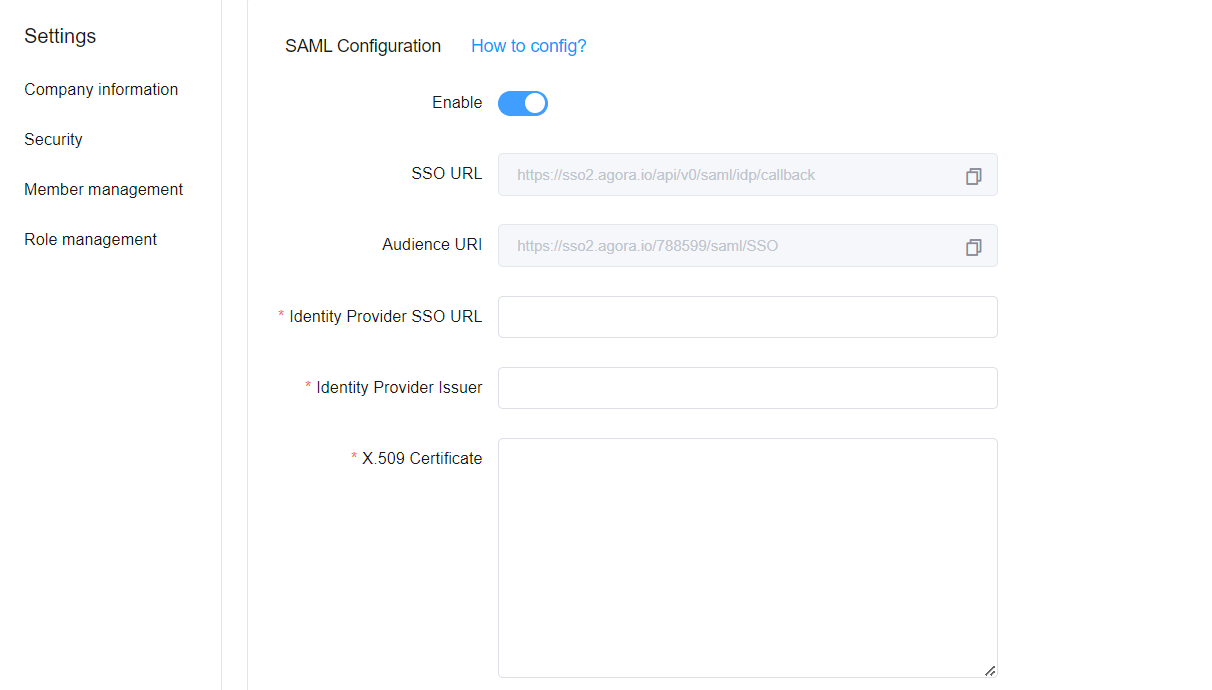
-
Create a SAML integration for Agora in Okta Console.
-
Log in to your Okta developer account as a user with administrative privileges and click Admin in the upper right corner.
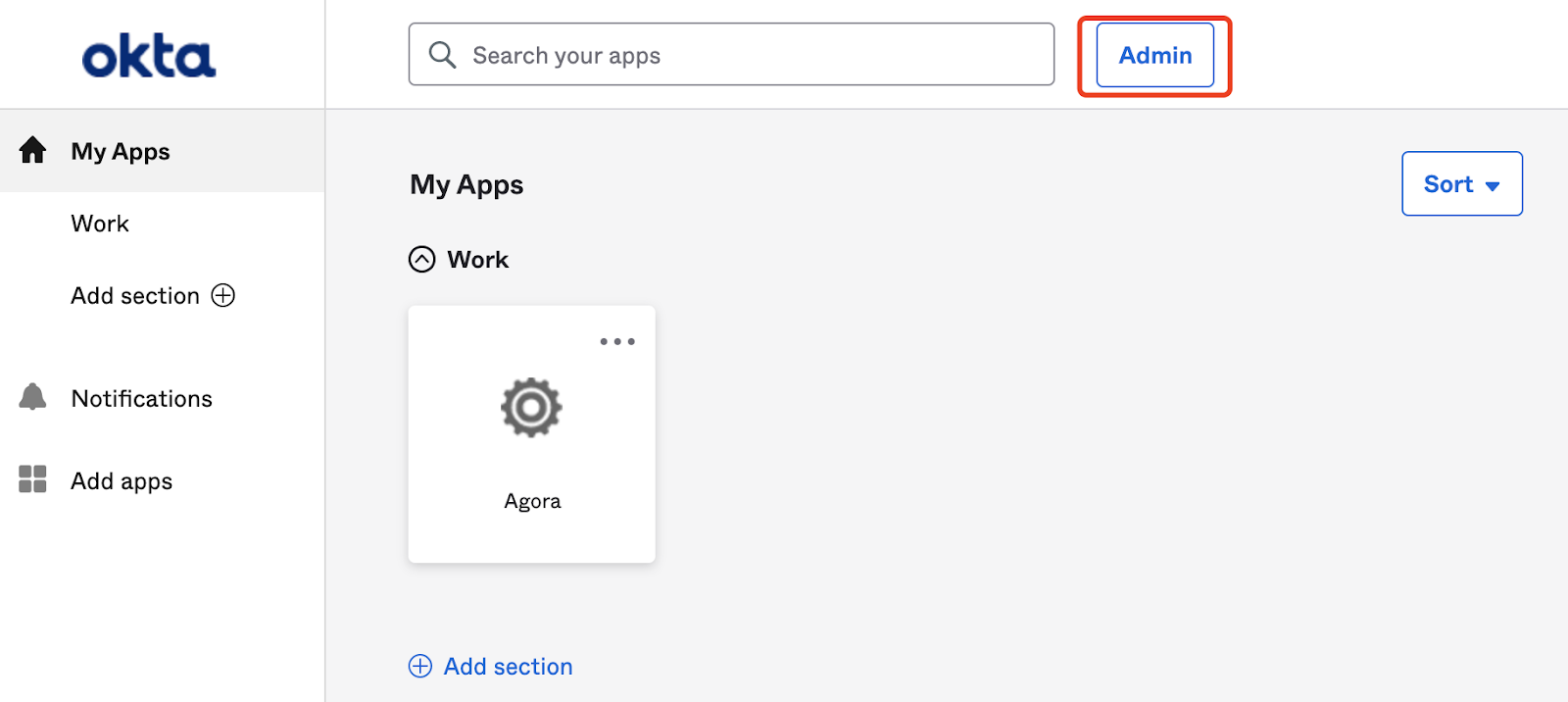
-
Go to Applications > Applications and click Create App Integration.
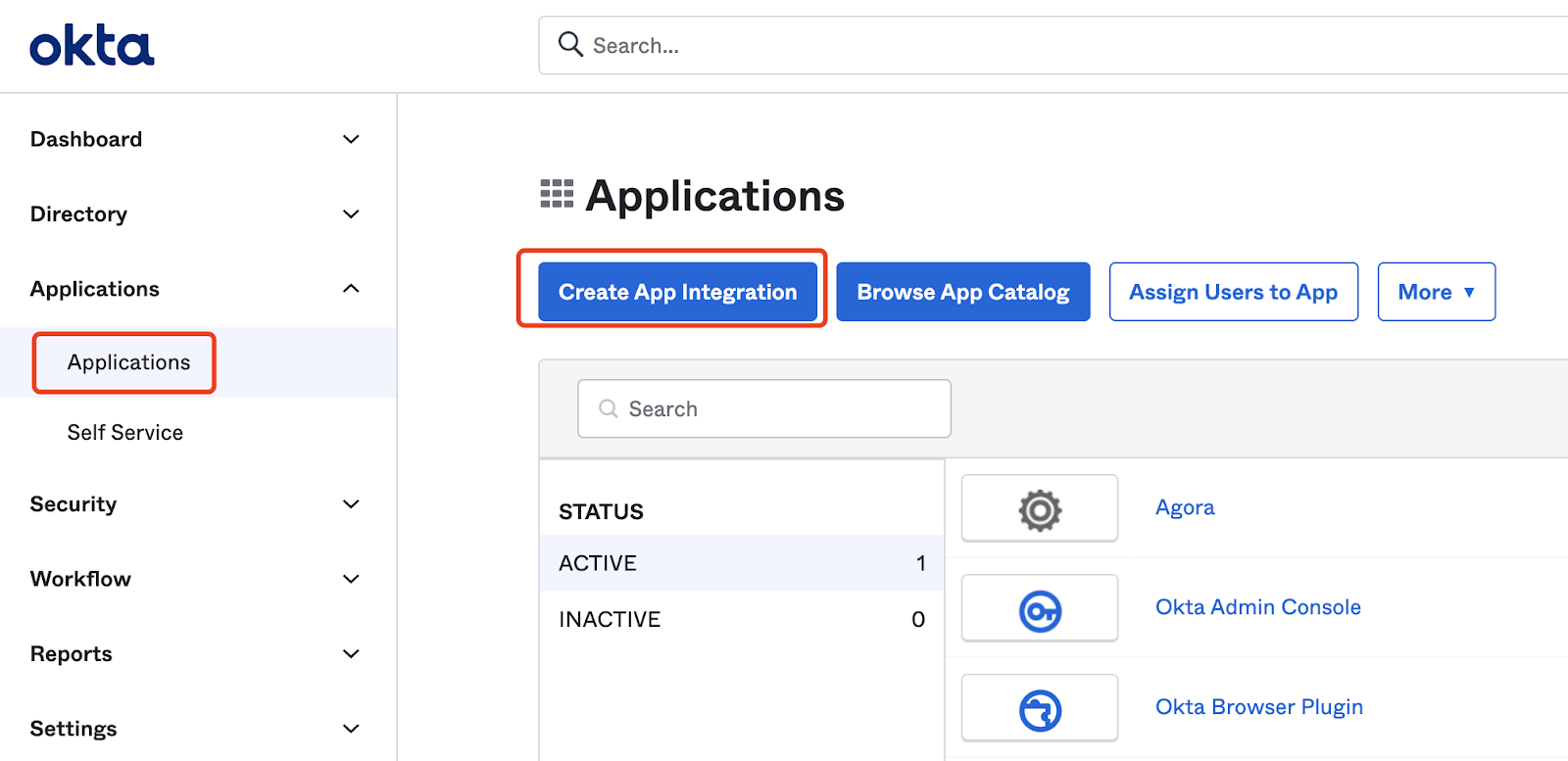
-
In the Sign-in method section, select SAML 2.0 and click Next.
-
On the General Settings tab, enter a name for this integration, for example,
Agora, and click Next. -
On the Configure SAML tab, fill in the following SAML configurations generated in Agora Console:
-
In the Single sign on URL field, enter
https://sso2.agora.io/api/v0/saml/idp/callback. -
In the Audience URI (SP Entity ID) field, enter
https://sso2.agora.io/{companyId}/saml/SSOwhere{companyId}is your company ID. -
In the Attribute Statements (optional) section, add the following attribute:
Name Value emailuser.email
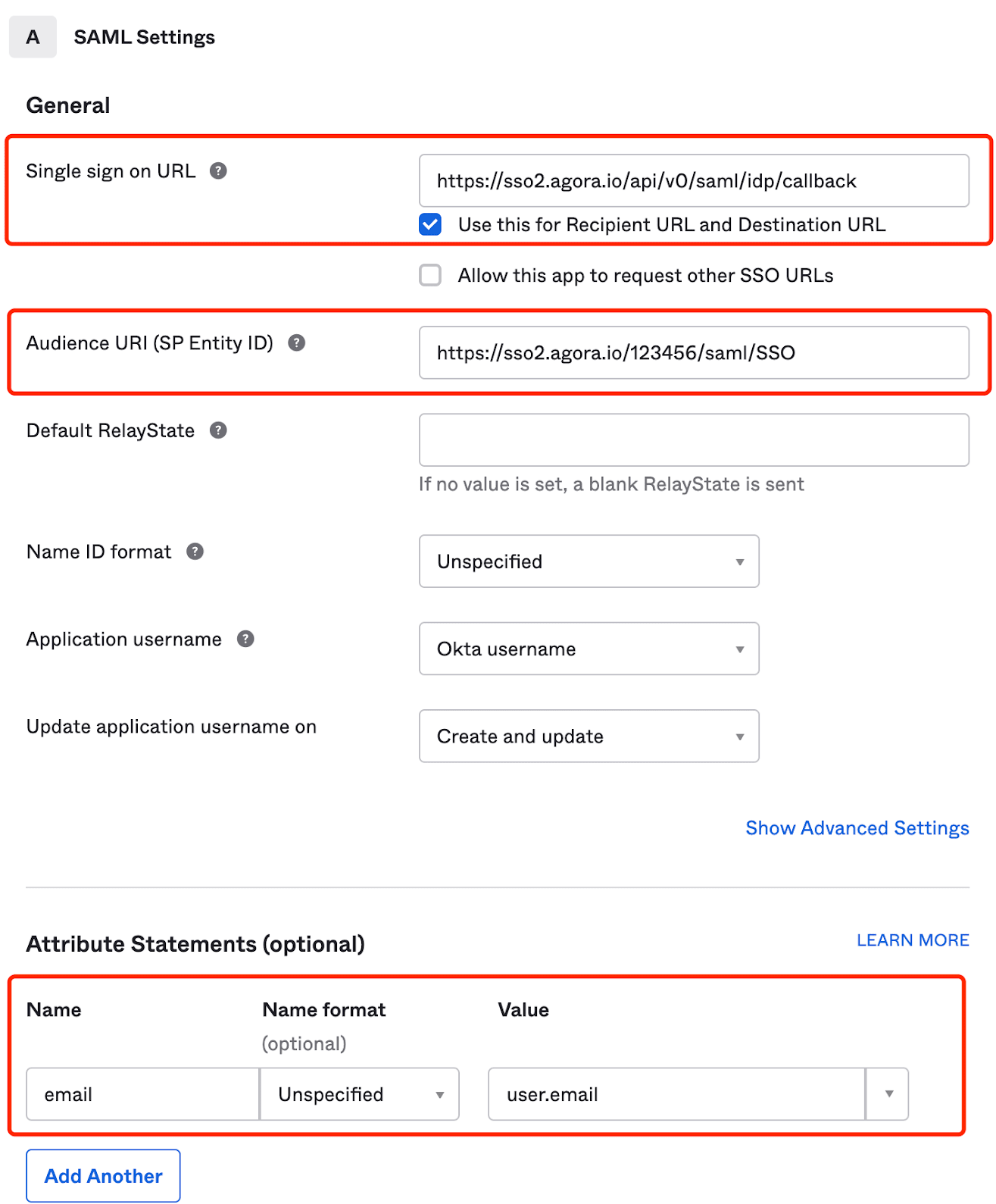
-
-
On the Feedback tab, select I'm an Okta customer adding an internal app and tick This is an internal app that we have created, then click Finish.
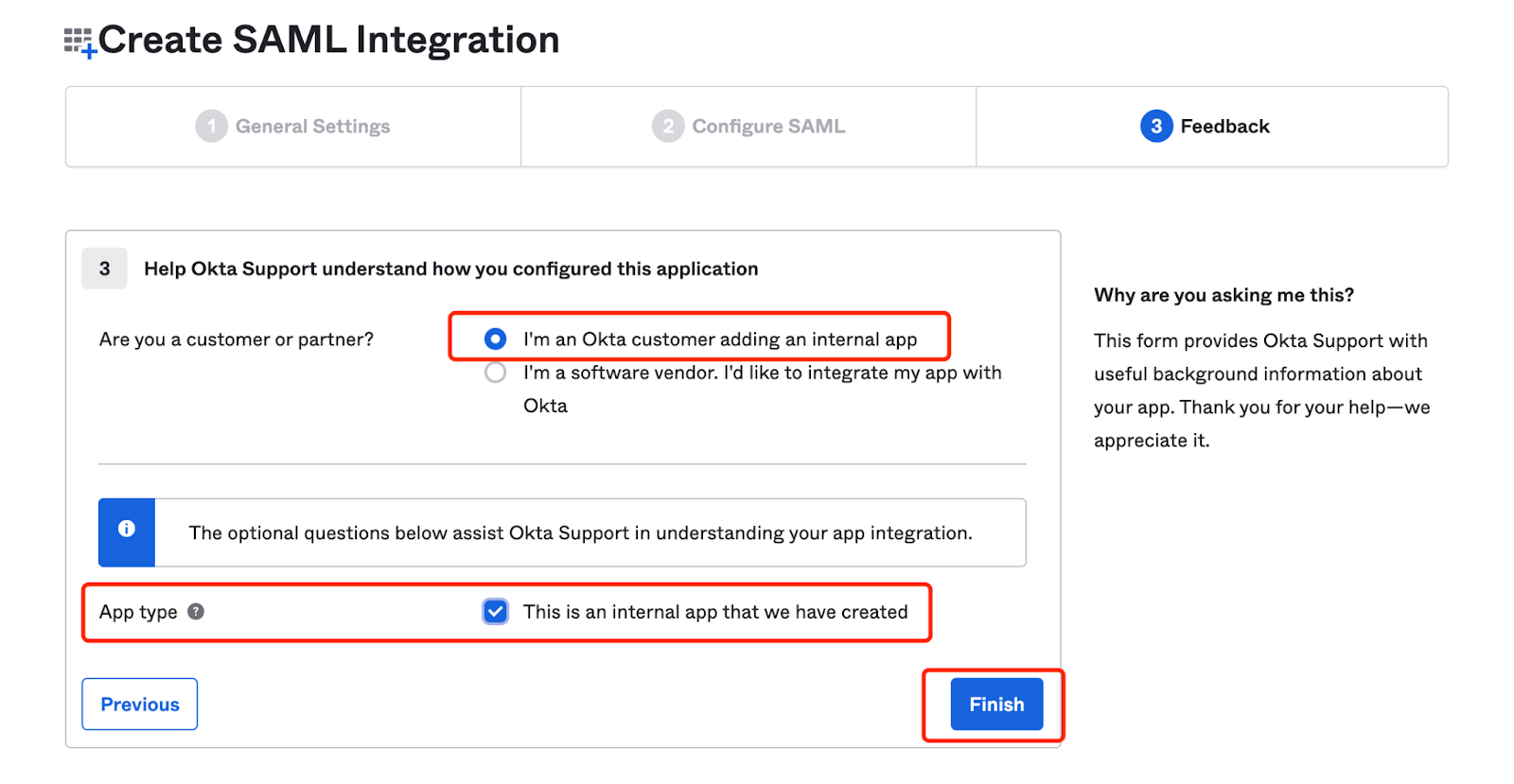
-
-
View IdP information in Okta Console
-
In Okta Console, select the Sign On tab for Agora integration and click View Setup Instructions. You see the following information:
- Identity Provider Single Sign-On URL: At the end of this procedure, your team members use this URL to sign in to Agora Console)
- Identity Provider Issuer
- X.509 Certificate
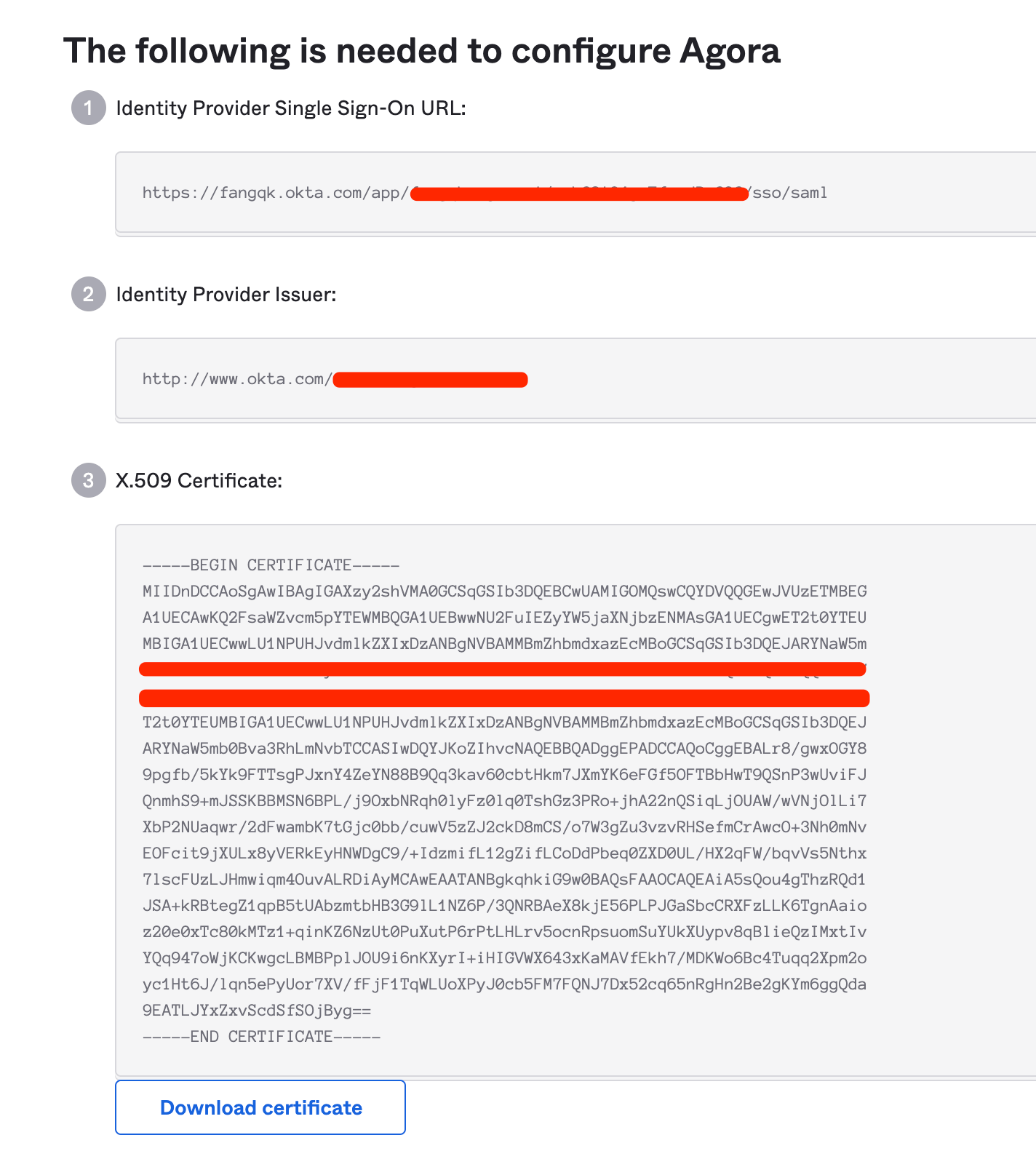
-
-
Configure SAML settings in Agora Console
In the SAML Configuration section on the SSO Management page in Agora Console, enter the following information from Okta Console:
- Identity Provider Single Sign-On URL
- Identity Provider Issuer
- X.509 Certificate, including the
BEGIN CERTIFICATEandEND CERTIFICATE lines.
Click Save.
-
Manage access
You can manage access for your team members manually using SAML, which is enabled when you apply for Okta integration in Agora Console, or automatically, if you additionally enable SCIM. Manual management means that adding, managing, and removing a team member's access must be done in both, Okta and Agora Console. Automatic management means that SCIM automatically adds, manages, and removes members' access to Agora Console when you make changes in Okta.
Note: Once enabled, SAML is applicable for both, existing and newly created Agora accounts for team members. For new accounts, however, log in as the admin in Agora Console and create an account before it is configured in Okta. SCIM is applicable only for new accounts.
-
Manual management with SAML
- In Agora Console, add team members and choose their roles. For details, see Manage Members and Roles.
- In Okta Console, go to Directory > People. Ensure that the email address of each team member is the same as that in Agora Console.
- Go to Applications > Applications > Agora integration.
- On the Assignments tab, click Assign and select Assign to People.
- Enter the team members that need to sign in to Agora Console and click Assign for each. Click Done.
-
Automated management with SCIM
-
In Agora Console, enable SCIM API Basic Auth on the SSO Management page. A set of username and password is generated, along with the SCIM connector base URL.
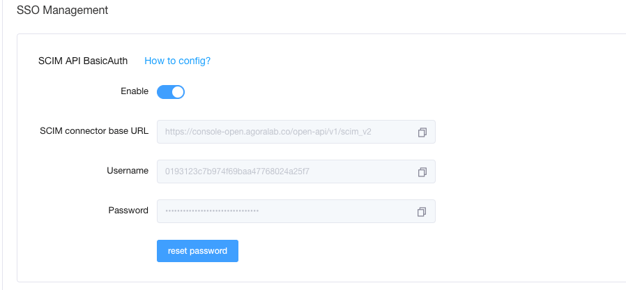
-
In Okta Console, select the General tab under Agora integration and click Edit.
-
In the Provisioning section, select SCIM and click Save.
-
Select the Provisioning tab under Agora integration, then under Settings > Integration click Edit. Make the following changes:
- In SCIM connector base URL, enter the corresponding URL from Agora Console.
- In Unique identifier field for users, enter
email. - Under Supported provisioning actions, tick all the checkboxes.
- In Authentication Mode, select Basic Auth.
- Under the Basic Auth section, enter the username and password from the SSO management page in Agora Console.
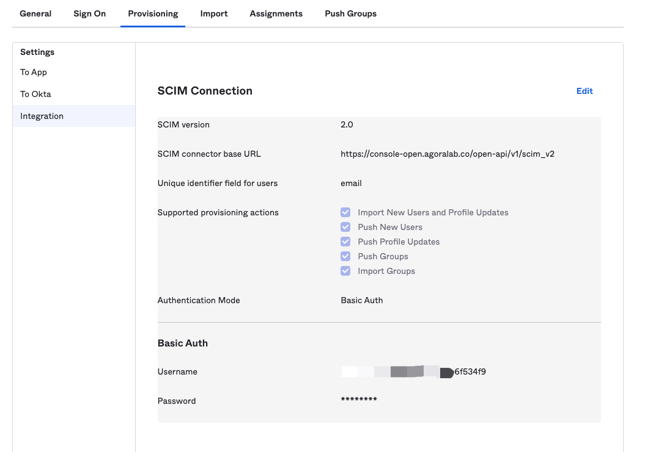
-
-
After enabling and configuring Okta integration, you can choose to enable the Big Bang feature. In this case, login to Agora Console with email and password is no longer available and your team members can log in only through Okta. To enable this feature, contact Agora support.
Billing Center
This page shows how to check your account balance, add money to your account, view transactions, and make a withdrawal in Agora Console.
Restrictions
If your account has multiple members, only those with the role of Admin, Finance, or an authorized custom role have access to the Billing Center page.
Check account balance
After logging in to Agora Console, you can see your account balance in the Billing Center panel on the Overview page.
Add money to account
You can add money to your account either with a credit card or via bank transfer.
Credit card
To add money to your account with a credit card, follow these steps:
-
In Billing Center, click Credit Card in the left navigation panel.
-
(Optional) If you have not added a credit card to your account, follow these steps:
-
Click Add a card.
-
Enter the card number, month, year, and CVC.
-
Choose whether or not to set this card as the default credit card.
-
Click Save.
-
-
Select a credit card, enter the Payment Amount, and click Pay. If the payment is successful, you see a "Payment Succeeded"message.
Bank transfer
To add money to your account via bank transfer, follow these steps:
-
In Billing Center, click Bank Transfer in the left navigation panel.
-
Follow the on-screen instructions to complete.
View transactions
In Billing Center, click Transactions in the left navigation panel. You can see all the transactions in your account.
You can also click Export CSV in the top-right corner to export the record of transactions as a CSV file.
Make a withdrawal
You can withdraw from your Agora account balance for free. Follow these steps to make a withdrawal:
-
In Billing Center, click Withdraw in the left navigation menu.
-
Click Request Withdrawal in the top-right corner.
-
Specify the amount you want to withdraw, and click OK.
After submitting a withdrawal request, you can track the request status on the Withdraw page.
Agora processes your withdrawal request within 10 business days. However, if your actual usage in the current month exceeds 10,000 minutes, your request is processed after the next billing day. Ensure that you have sufficient funds in your account to cover any pending charges.
After your request is approved, your money is returned to your credit card.
Submit a ticket
To ask Agora support a question:
Follow these steps:
-
Log in to Agora Console.
-
Click Support in the top navigation menu.
-
Type in your question or keywords to see if the question has been answered. If you cannot find your answer, select a category and submit a ticket to Agora’s customer support.
You can track the status of your ticket under Tickets.
Delete Your Agora Account
This article describes how to delete your Agora account created with an email address or phone number.
Prerequisites
Before deleting your Agora account, ensure that the following requirements are met:
-
You are the creator of the account to be deleted.
-
The account to be deleted is an Agora account created in Agora Console, not a reseller account created in Agora Reseller Console.
-
There are no active projects under your account. If there are any, go to the Project Management page to disable all active projects.
-
Your account balance is zero.
-
If your account balance is positive, go to the Withdraw page to request a withdrawal.
-
If your account balance is negative, go to Billing Center to add money to your account.
-
Your bill for last month has been issued.
-
No usage is generated in the current month.
-
All of your packages have either expired or been used up, including:
-
Video SDK and Cloud Recording packages.
-
Support packages.
-
Extensions Marketplace packages.
-
There are no members under your account. If there are any, go to the Member Management page to delete all members.
Procedure
Follow these steps to delete your Agora account:
-
Log in to Agora Console, click your account name in the top-right corner, and click Setting in the dropdown menu. s
-
In the left navigation panel, click Security.
-
At the bottom of the Security page, find Delete account. Ensure that you meet all the prerequisites, and click Delete Account.
-
Read the pop-up prompt carefully, and click Continue.
If any prerequisite is not met, an error message appears after you click Continue. Check the Prerequisites and try again.
-
Fill in the reason why you want to delete your account, enter the admin email address for this account, and click I understand all the risks and want to continue.
The admin email address is the email address you use to sign up for this account. You can find it on the Profile page.
-
Follow the pop-up prompt to verify your identity.
-
Ensure that you fully understand the risks of deleting an account, and click Submit request.
After receiving your account deletion request, Agora sends you an email for confirmation and processes the request within a week.
Once the request is approved, Agora deletes your account and notifies you by email.